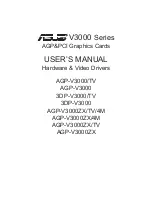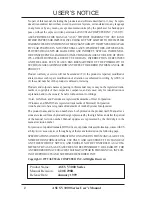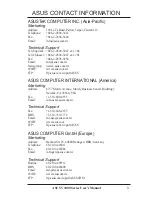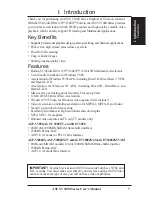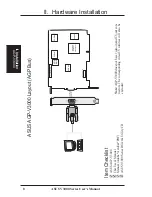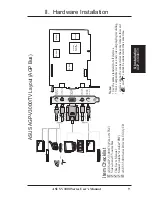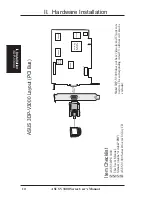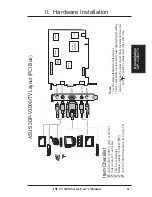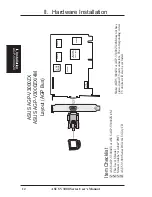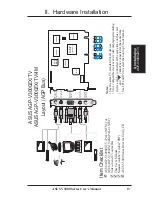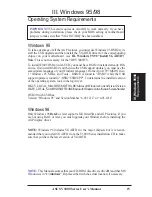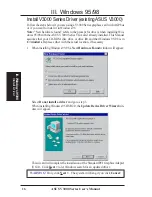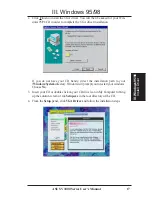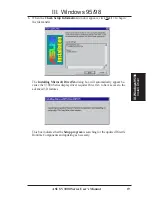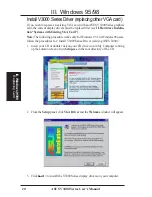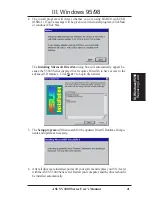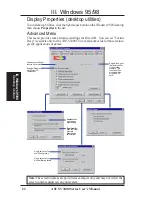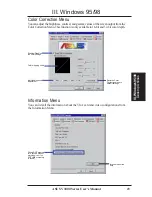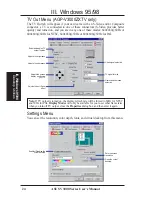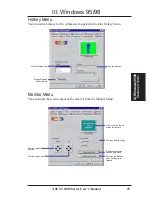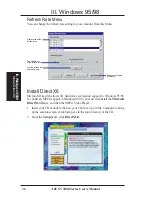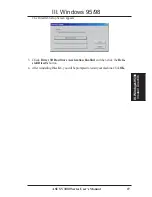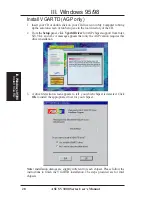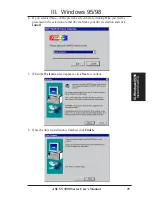
ASUS V3000 Series User’s Manual
14
III. Windows 95/98
III. W
indows 95/98
Procedures
Installation Procedures
New Systems
1. Unplug all electrical cords on your computer.
2. Remove the system unit cover.
3. Locate the AGP or PCI bus expansion slot. Make sure this slot is unobstructed.
4. Remove the corresponding expansion slot cover from the computer chassis.
5. Ground yourself to an antistatic mat or other grounded source (see
WARNING!
).
6. Pick up the board (still in its sleeve) by grasping the edge bracket with one hand
and then remove the plastic sleeve.
7. Position the card directly over the AGP slot and insert one end of the board in
the slot first. Firmly but gently press the bus connector on the bottom of the card
down into the slot. Be sure the metal contacts on the bottom of the host adapter
are securely seated in the slot.
8. Anchor the board’s mounting bracket to the computer chassis using the screw
from the slot cover that you set aside previously.
9. Replace the cover on the system unit.
10. Connect your analog monitor’s 15-pin VGA connector to the card and fasten the
retaining screws (if any).
11. Connect other cables and devices if available -You are now ready to install the
software drivers and utilities.
Systems with Existing VGA Card
1. Install the ASUS V3000 Series display drivers with your current VGA card.
2. Shut down your computer and unplug all electrical cords.
3. Replace the existing VGA card with the ASUS V3000 Series graphics card.
4. Restart your computer — the ASUS V3000 Series graphics card should be auto-
matically detected and the display drivers automatically updated.
NOTE: The ASUS AGP-V3000, AGP-V3000/TV, AGP-V3000ZX and AGP-
V3000ZXTV can only be installed in motherboards with an AGP slot. The ASUS
3DP-V3000 and 3DP-V3000/TV can be installed in standard PCI motherboards.
WARNING!
Computer boards and components contain very delicate Integrated
Circuit (IC) chips. To protect the computer board and other components against
damage from static electricity, you must follow some precautions.
1. Make sure that you unplug your power supply when adding or removing
expansion cards or other system components. Failure to do so may cause
severe damage to both your motherboard and expansion cards.
2. Keep all components, such as the host adapter, in its antistatic bag until you
are ready to install it.
3. Use a grounded wrist strap before handling computer components. If you do
not have one, touch both of your hands to a safely grounded object or to a
metal object, such as the power supply case. Hold components by the edges
and try not to touch the IC chips, leads, or circuitry.
4. Place components on a grounded antistatic pad or on the bag that came with the
component whenever the components are separated from the system.

